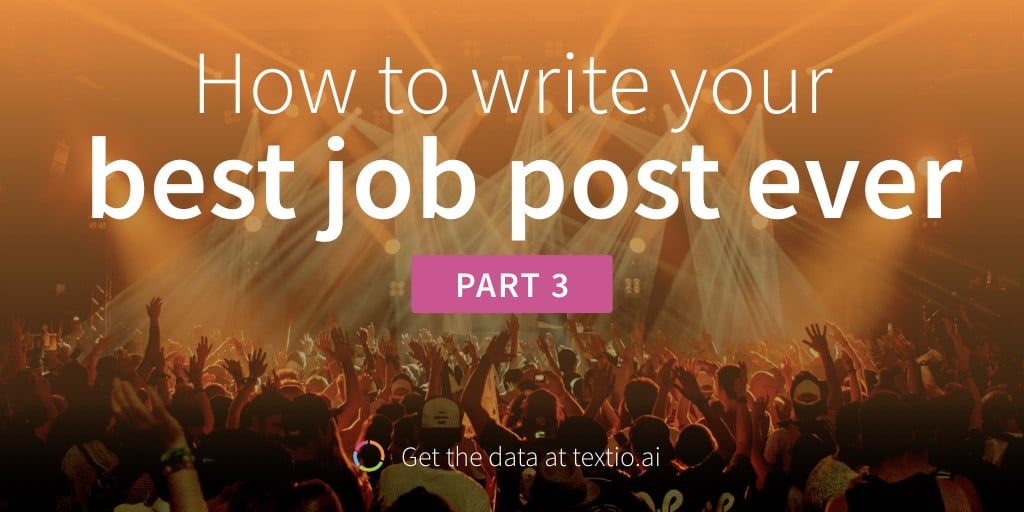How to write your best job post ever: Part 3

This is part 3 in a series I’m writing where I use data to help you write better job posts. Last week in part 2 we talked about how to write a concise, to-the-point job post that won’t scare applicants away at first glance. (And don’t miss part 1, where I lay out the key elements of a good job post).
Textio’s writing guidance is based on a constant analysis of huge amounts of data. Almost 10 million new job posts are added to the platform every month, along with information about how they perform with real people.
Working with Textio’s data has taught me that the best job listings engage candidates by presenting the role and your company in a compelling way. We’ll look at two techniques that Textio has uncovered to help you better engage with job seekers:
- Speaking directly to the potential employee
- Showcasing your company values
Answering “will I fit in?” and other important questions
When you’re looking for a job, reading a job post is the first and most important way to tell what a company will be like to work for. As a hiring manager writing a job post, it’s your responsibility to make sure the mental picture someone conjures when they read your listing is a good (nay, great!) one.
Imagine the questions that run through a job seeker’s head before making the jump: Will I learn? Will I enjoy the culture? Am I going to be challenged and grow? Will I like my day-to-day responsibilities?
Textio consistently finds that the most successful job listings answer these questions by directly addressing candidates with both “you” and “we” statements. In fact, listings that use formal or indirect phrasing like “the ideal candidate” cause roles to fill more slowly on average.
Phrasing like “the ideal candidate” cause roles to fill more slowly on average.
The data also shows us that the ratio of “you” and “we” statements is critical to attracting the most qualified people. Having a nearly 1-to-1 balance of “you” and “we” statements is ideal for any job post.

Try to strike a balance between:
- Telling job seekers what they’ll be doing in the role, and
- Telling them how their work will fit to your company’s goals
An example from our own Textio job post: “You embrace technology in how you do your work —we are pretty nerdy!”
Many people will spend the majority of their waking hours at work. If they can’t picture themselves accomplishing something meaningful during their time with your company, why would they bother even applying?
Hire fairly, or else
Textio’s data shows a strong correlation between listing engagement and a company’s stated commitment to fair hiring practices. So strong, in fact, that job posts with an equal opportunity statement fill 10% more quickly on average.
This isn’t a fluke. Textio collects data from companies all around the world, not just in the U.S. where equal opportunity language stems from the Civil Rights Act. Across Textio’s global data there’s an increasingly clear trend towards transparent and fair hiring practices. The more you can display that in your job listings, the more qualified candidates will want to work for you.
The data is clear — people across all demographics prefer to work for inclusive companies. To engage the biggest pool of strong candidates, you need to use inclusive language.
The data is clear — people across all demographics prefer to work for inclusive companies.
But just stating that your company is an “Equal Opportunity, Affirmative Action Employer” isn’t enough. In fact, Textio found that job listings using the bare minimum for their equal opportunity statement saw worse hiring results than jobs that had no equal opportunity statement at all.
You can also optimize the language within your equal opportunity statement:

Try editing your listings with these techniques in mind now! And tune in next week! Now that you have attracted and engaged the best talent, I’ll show you how to use data to convince them to apply.
In case you missed the other parts in our series, you can find them here: Part 1, Part 2, Part 4, and Part 5.